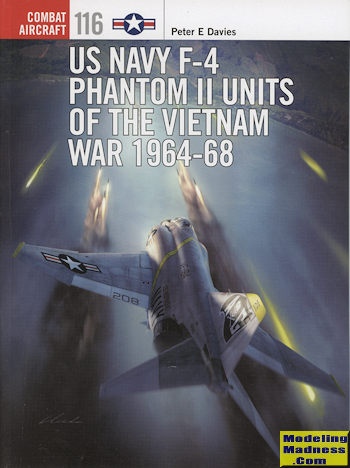 Let me
start this by stating that I'm a big fan of the subject, so it was with much
interest that I started reading this book. As you might imagine, this isn't the
first book on the subject, but it is the first I've read that concentrates on
the aircraft's combat career during this particular period of time. The book
provides mostly information on F-4B operations and just finishes up with the
initial F-4J deployments.
Let me
start this by stating that I'm a big fan of the subject, so it was with much
interest that I started reading this book. As you might imagine, this isn't the
first book on the subject, but it is the first I've read that concentrates on
the aircraft's combat career during this particular period of time. The book
provides mostly information on F-4B operations and just finishes up with the
initial F-4J deployments.
It covers some of the development of the type along with the operating
parameters of the plane's main weapons. Considering that the F-4 relied on
missiles, it is a shame that these weapons were not better suited to the task at
hand. Of course one has to consider that the F-4 was designed as an interceptor
and it was expected to operate against large masses of slow maneuvering Soviet
bombers, not highly agile MiG-17s and later fast MiG-21s. As such, the Sparrows
and Sidewinders proved to be less than ideal.
Many of the units forming on the F-4 were previously flying the F-8
Crusader, a plane that had a gun and they were fairly successful with the type.
New tactics had to be developed by F-4 crews when operating against North
Vietnamese MiGs. However, like their USAF counterparts, most of the missions
were devoid of air to air combat and the Phantom was used probably more as a
fighter bomber than anything else.
The book covers operations from not only Pacific fleet carriers, but
also those that came over from the Atlantic fleet. Such was the congestion over
North Vietnam, that the Navy and Air Force had to divide the country into
sections to ensure that there were no issues of missions overlapping and perhaps
causing issues with mid-air collisions. As it was, the most difficult part of
any of these missions was from ground fire. Unlike the Air Force's F-105s, the
hydraulic lines in the Phantom II could not be fully routed in the upper spine
of the plane and not surprisingly, most Phantom losses were due to a loss of
hydraulic pressure. This is very much a case of where one bullet could ruin a
crew's day. So tightly packed was the airframe that even adding armor was not
possible.
The book is full of great photos of planes and crews. Interestingly,
many of the images are of planes that were lost in combat. To go along with the
great period color photos are several pages of equally great color profiles of
the aircraft involved in the conflict. In addition to combat stories, the
various modifications made to the aircraft are included. This includes the
original F-4G, a standard F-4B fitted with a data link system (which I believe
was Link 11), one which was later fully adopted into the fleet (and by that I
mean years later) which allowed the plane to be flown from the ground. Hooking
this into the ACLS or automatic carrier landing system, took a lot of the worry
out of landing during rough seas. Though most crews were quite wary of the
system due to the many bugs, one feature they really liked was the
auto-throttle.
Now, let me put in one observation that probably only those who worked
on or around the planes (such as your reviewer) would notice and this is not
even on the Phantom II. The author continually refers to the EKA-3B jammers of
the VAQ squadrons as EA-3Bs. The EA-3Bs were strictly ELINT (Electronic
Intelligence) aircraft that had no offensive capabilities at all. These planes
were operated by VQ (fleet air reconnaisance) squadrons. The EKA-3Bs had actual
bomb bays that could carry a tanker package and huge bomb bay-filling chaff
dispensers as well as the the electronic jammers. All EKA-3Bs were converted
KA-3Bs and were the planes that lead many of the strike missions in order to jam
enemy radars from radar equipped AAA and SAM sites.
Anyway, despite this minor item, the book is very well done and is one
that any enthusiast of the type or the period will want on their shelves.
September 2016
Copyright ModelingMadness.com. All rights reserved.
For more on the complete line of Osprey books,
visit www.ospreypublishing.com
If you would like your product reviewed fairly and
fairly quickly, please
contact the editor or see other details in the
Note to
Contributors.
 Let me
start this by stating that I'm a big fan of the subject, so it was with much
interest that I started reading this book. As you might imagine, this isn't the
first book on the subject, but it is the first I've read that concentrates on
the aircraft's combat career during this particular period of time. The book
provides mostly information on F-4B operations and just finishes up with the
initial F-4J deployments.
Let me
start this by stating that I'm a big fan of the subject, so it was with much
interest that I started reading this book. As you might imagine, this isn't the
first book on the subject, but it is the first I've read that concentrates on
the aircraft's combat career during this particular period of time. The book
provides mostly information on F-4B operations and just finishes up with the
initial F-4J deployments.